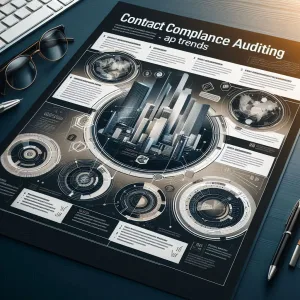Introduction to Internal Audit and MAR Audit
In the realm of corporate governance, the internal audit function plays a pivotal role in ensuring that organizations operate efficiently, effectively, and in compliance with applicable laws and regulations. Internal audit is an independent appraisal activity designed to evaluate and improve the effectiveness of risk management, control, and governance processes within an organization. Its primary objectives include:
- Risk Assessment: Identifying and assessing risks that could impede the achievement of organizational objectives.
- Control Evaluation: Evaluating the adequacy and effectiveness of internal controls in mitigating identified risks.
- Governance Assurance: Providing assurance to the board and senior management regarding the integrity of financial reporting and compliance with laws and regulations.
On the other hand, the Model Audit Rule (MAR) audit is a specialized area that focuses on compliance with regulations designed to prevent market abuse, including insider trading and market manipulation. MAR audits are significant for several reasons:
- Regulatory Compliance: They ensure that organizations adhere to stringent market regulations, thereby avoiding legal penalties and reputational damage.
- Market Integrity: By promoting transparency and fairness in the financial markets, MAR audits contribute to maintaining investor confidence and market stability.
Both internal audit and MAR audit share a common foundation in compliance and risk management. The importance of these elements cannot be overstated, as they are critical for the following reasons:
- Holistic Risk Management: Internal auditors must incorporate MAR audit processes to enhance their understanding of market-related risks, which can significantly impact the organization’s overall risk profile.
- Strengthened Compliance Framework: By aligning internal audit activities with MAR requirements, organizations can create a more robust compliance framework that addresses both operational and market-related risks.
- Enhanced Governance: The collaboration between internal audit and MAR audit fosters a culture of accountability and transparency, which is essential for effective governance.
Understanding the foundational aspects of internal audit and MAR audit is crucial for internal auditors and audit committee members. By recognizing their objectives and significance, stakeholders can appreciate the symbiotic relationship between these two audit functions, ultimately leading to improved organizational performance and compliance.
Understanding MAR Audit Processes
The Model Audit Rule (MAR) audit processes play a crucial role in enhancing the effectiveness of internal audits within insurance organizations. By integrating MAR audit processes, internal auditors can significantly improve their monitoring, reporting, and compliance functions. Below are the key components and considerations surrounding MAR audits.
Key Components of MAR Audit
- Monitoring: MAR emphasizes the importance of continuous monitoring of internal controls over financial reporting. This involves regular assessments to ensure that the controls are functioning effectively and are aligned with regulatory requirements. The ongoing nature of monitoring helps in identifying potential weaknesses or areas for improvement in real-time, allowing organizations to address issues proactively [1].
- Reporting: Accurate and timely reporting is a fundamental aspect of MAR audits. Insurers are required to provide comprehensive reports that reflect their financial status and the effectiveness of their internal controls. This transparency not only aids in regulatory compliance but also builds trust with stakeholders by ensuring that financial statements are reliable and free from material misstatements [13].
- Compliance: Compliance with MAR is non-negotiable for insurance companies. The rule establishes rigorous standards that organizations must adhere to, including auditor independence and corporate governance. By ensuring compliance, internal auditors can help mitigate risks associated with financial reporting and enhance the overall integrity of the organization’s financial practices [11][15].
Regulatory Framework Governing MAR Audits
The MAR was developed by the National Association of Insurance Commissioners (NAIC) to impose stringent financial reporting and auditing requirements on insurance companies. The framework is designed to enhance the reliability of financial statements and ensure the integrity of reporting practices. Key aspects of the regulatory framework include:
- Auditor Independence: MAR mandates that auditors maintain independence from the organizations they audit, which is essential for unbiased reporting and assessment of internal controls [12].
- Corporate Governance: The rule outlines the governance structures that must be in place to support effective internal controls and audit processes, ensuring that there is accountability at all levels of the organization [11].
- Internal Control Standards: MAR requires organizations to establish and maintain robust internal control systems that are regularly evaluated and tested to ensure their effectiveness in safeguarding financial reporting [10][13].
Role of Technology and Data Analytics in MAR Audits
The integration of technology and data analytics into MAR audits is transforming the auditing landscape. Here’s how these tools enhance the audit process:
- Data Analytics: Automated tools and techniques are employed to analyze large volumes of data, allowing auditors to identify trends, anomalies, and potential risks more efficiently than traditional methods. This capability is particularly beneficial in assessing the effectiveness of internal controls and ensuring compliance with MAR requirements [3][7].
- Enhanced Risk Management: By leveraging data analytics, internal auditors can conduct more thorough risk assessments, enabling them to focus on areas of higher risk and allocate resources more effectively. This proactive approach to risk management is essential in today’s complex regulatory environment [4].
- Operational Efficiency: The use of technology streamlines audit processes, reducing the time and effort required for manual reviews. This efficiency not only improves the quality of audits but also allows internal auditors to dedicate more time to strategic initiatives and value-added activities [6][8].
The incorporation of MAR audit processes into internal audit functions provides a robust framework for enhancing monitoring, reporting, and compliance. By understanding the key components, regulatory requirements, and the role of technology, internal auditors and audit committee members can better navigate the complexities of the auditing landscape and contribute to the overall success of their organizations.
The Benefits of Integrating MAR Audit with Internal Audit
In the realm of internal auditing, the integration of the Model Audit Rule (MAR) processes can significantly enhance the effectiveness and efficiency of audit functions. This symbiotic relationship not only bolsters the internal audit’s capabilities but also aligns with the broader objectives of risk management and compliance. Here are some key benefits of incorporating MAR audit processes into internal audit functions:
- Enhanced Risk Identification and Assessment: By adopting a combined approach that includes MAR audit processes, internal auditors can improve their ability to identify and assess risks. The MAR framework emphasizes a robust internal control environment, which aids auditors in pinpointing areas of highest risk and focusing their efforts accordingly. This collaboration ensures that audit activities are aligned with the organization’s risk profile, leading to more informed decision-making and proactive risk management [1][11].
- Improved Compliance with Regulatory Requirements: The MAR establishes clear guidelines and standards for internal controls and audit processes, which helps organizations comply with regulatory requirements. By integrating MAR audit processes, internal auditors can ensure that their activities are in line with these regulations, thereby reducing the likelihood of non-compliance and associated penalties. This proactive stance not only safeguards the organization’s reputation but also fosters a culture of compliance throughout the organization [10][12].
- Strengthened Internal Controls Leading to Increased Operational Efficiency: The MAR framework is designed to enhance the governance and oversight of internal controls, which can lead to improved operational efficiency. By incorporating MAR audit processes, internal auditors can streamline their procedures, reduce redundancies, and enhance the accuracy of financial reporting. This not only mitigates risks but also optimizes resource allocation, allowing organizations to operate more effectively and efficiently [13][14].
The integration of MAR audit processes into internal audit functions presents a multitude of benefits, including enhanced risk management, improved compliance, and strengthened internal controls. By embracing this symbiotic relationship, internal auditors can significantly contribute to the overall governance and accountability of their organizations, ultimately driving greater value for stakeholders.
Practical Steps for Integration
Incorporating Model Audit Rule (MAR) processes into internal audit functions can significantly enhance the effectiveness and compliance of audit activities. Here are some actionable steps that internal auditors and audit committee members can take to create a symbiotic relationship between internal audit and MAR audit processes:
- Develop a Collaborative Framework: Establishing a collaborative framework between internal audit and MAR audit teams is crucial. This can involve regular meetings to discuss audit findings, share insights, and align objectives. By fostering open communication, both teams can work together to identify areas of risk and ensure that MAR compliance is integrated into the overall audit strategy. This collaboration can lead to a more comprehensive understanding of the regulatory landscape and enhance the quality of audits conducted [12][15].
- Leverage Data Analytics Tools: Utilizing data analytics tools can streamline the integration of MAR audit processes into internal audits. These tools can help in identifying trends, anomalies, and areas of concern within financial reporting and internal controls. By analyzing large volumes of data, internal auditors can gain insights that inform their audit approach and enhance the effectiveness of MAR compliance efforts. This data-driven approach not only improves efficiency but also supports more informed decision-making [6][13].
- Establish Regular Training Sessions: Continuous education is vital for keeping audit staff updated on MAR compliance requirements. Regular training sessions can be organized to cover the latest developments in MAR regulations, best practices, and case studies. This ensures that internal auditors are well-equipped to address compliance challenges and understand the implications of MAR on their audit processes. By investing in training, organizations can enhance the competency of their audit teams and ensure adherence to regulatory standards [11][14].
By implementing these practical steps, internal audit functions can effectively incorporate MAR audit processes, leading to improved compliance, enhanced risk management, and a stronger overall audit framework. This integration not only benefits the internal audit team but also strengthens the organization’s governance and accountability in financial reporting.
Challenges and Considerations
Integrating Model Audit Rule (MAR) processes into internal audit functions presents a unique set of challenges that organizations must navigate. Understanding these barriers and addressing them effectively is crucial for internal auditors and audit committee members aiming to enhance their audit practices. Here are some common challenges and considerations:
Common Barriers to Integration
- Resource Allocation: One of the primary challenges in integrating MAR audit processes is the allocation of sufficient resources. Many organizations struggle with limited budgets and personnel, which can hinder the implementation of comprehensive MAR compliance strategies. This scarcity can lead to inadequate audit coverage and oversight, ultimately affecting the quality of internal audits [5][15].
- Expertise Gaps: The complexity of MAR requirements often necessitates specialized knowledge that may not be readily available within the existing internal audit team. This expertise gap can result in difficulties in understanding and applying MAR standards effectively, leading to compliance risks and potential regulatory issues [10][12].
Importance of Leadership Support
Leadership support is vital in overcoming the challenges associated with integrating MAR audit processes. When senior management and the audit committee prioritize MAR compliance, it fosters a culture of accountability and commitment to high standards. This support can manifest in several ways:
- Commitment to Training: Leadership can facilitate training programs to upskill internal audit staff, ensuring they are well-versed in MAR requirements and best practices. This investment in human capital can help bridge the expertise gap and enhance the overall effectiveness of the audit function [6][12].
- Resource Allocation: Strong leadership can advocate for the necessary resources, both financial and human, to support the integration of MAR processes. By recognizing the importance of compliance, leaders can help secure budgets and personnel dedicated to MAR audits, thereby alleviating some of the resource constraints faced by internal audit teams [5][15].
Solutions to Mitigate Risks
To successfully integrate MAR audit processes and mitigate associated risks, organizations can adopt several strategies:
- Develop a Structured Implementation Plan: A well-defined implementation plan can guide the integration process, outlining specific steps, timelines, and responsibilities. This structured approach helps ensure that all aspects of MAR compliance are addressed systematically, reducing the likelihood of oversight or errors [9].
- Leverage External Expertise: Engaging third-party consultants with expertise in MAR compliance can provide valuable insights and support during the integration process. These professionals can assist in identifying gaps, developing training programs, and ensuring that internal audit practices align with MAR requirements [15].
- Foster Collaboration: Encouraging collaboration between internal audit teams and other departments, such as compliance and risk management, can enhance the integration process. By working together, these teams can share knowledge, resources, and best practices, ultimately leading to a more cohesive approach to MAR compliance [12].
While integrating MAR audit processes into internal audit functions presents challenges, proactive measures can be taken to address these barriers. By securing leadership support, allocating resources effectively, and fostering collaboration, organizations can enhance their internal audit practices and ensure compliance with MAR standards.
Future Trends in Internal Audit and MAR Audit
The landscape of internal audit is rapidly evolving, particularly with the integration of MAR audits. This symbiotic relationship between internal audit functions and MAR audits is increasingly influenced by emerging technologies and regulatory changes. Here are some key trends shaping this dynamic:
1. Emerging Technologies in Auditing
- Artificial Intelligence (AI) and Machine Learning: These technologies are revolutionizing the auditing process by enabling auditors to analyze vast amounts of data quickly and accurately. AI can identify patterns and anomalies that may indicate potential market abuse, enhancing the effectiveness of MAR audits. Machine learning algorithms can continuously learn from new data, improving their predictive capabilities over time, which is crucial for both internal and MAR audits [1].
- Data Analytics: The use of advanced data analytics tools is becoming central to internal audit functions. These tools allow auditors to perform more thorough examinations of transactions and behaviors, which is essential for detecting irregularities related to market abuse. By leveraging data analytics, internal auditors can provide deeper insights into compliance with MAR, thus strengthening the overall audit process [13][14].
2. Future Regulatory Trends Affecting MAR Audits
- Increased Regulatory Scrutiny: As regulatory bodies continue to emphasize the importance of compliance with MAR, internal auditors will need to adapt their practices to meet these heightened expectations. This may involve more rigorous testing of controls and processes related to market abuse, ensuring that organizations are not only compliant but also proactive in their approach to risk management [3][11].
- Focus on Cybersecurity and Data Privacy: With the rise of digital transactions, regulators are likely to place greater emphasis on cybersecurity measures within MAR audits. Internal audit functions will need to ensure that adequate safeguards are in place to protect sensitive data and prevent breaches that could lead to market abuse. This trend underscores the importance of integrating cybersecurity assessments into the audit process [12][14].
3. Continuous Improvement and Adaptation in Audit Practices
- Agility in Audit Methodologies: The fast-paced nature of regulatory changes and technological advancements necessitates that internal audit functions remain agile. This means continuously updating audit methodologies to incorporate new tools and techniques that enhance the effectiveness of both internal and MAR audits. Embracing a culture of continuous improvement will be vital for auditors to stay ahead of emerging risks and compliance requirements [4][6].
- Collaboration Across Functions: The integration of MAR audits into internal audit functions will require enhanced collaboration between different departments, including compliance, risk management, and IT. By fostering a collaborative environment, organizations can ensure that all aspects of market abuse are addressed comprehensively, leading to more effective audits and better risk management outcomes [12][15].
The future of internal audit and MAR audit is characterized by the integration of advanced technologies, a proactive approach to regulatory compliance, and a commitment to continuous improvement. By embracing these trends, internal auditors can enhance their effectiveness and contribute significantly to their organizations’ overall governance and risk management strategies.
Conclusion
In conclusion, the relationship between internal audit and MAR audit is undeniably symbiotic, offering significant benefits to both functions. By integrating MAR audit processes into internal audit functions, organizations can enhance their overall governance, risk management, and internal control frameworks.
- Symbiotic Relationship: The collaboration between internal audit and MAR audit fosters a more comprehensive understanding of the organization’s risk landscape. This integration allows internal auditors to leverage insights from MAR audits, leading to more informed decision-making and improved audit outcomes. The trust and transparency established through this relationship are essential for driving meaningful improvements within the organization’s governance and risk management practices [3][4].
- Embracing Integration: Audit professionals are encouraged to embrace the integration of MAR audit processes into their internal audit functions. This approach not only enhances the effectiveness of audits but also ensures that the organization is better equipped to identify and mitigate risks. By adopting a holistic view of risk management, internal auditors can provide greater assurance regarding the effectiveness of internal controls and the overall risk environment [5][12].
- Support from Audit Committees: It is crucial for audit committees to actively support integration initiatives between internal audit and MAR audit processes. By fostering an environment that encourages collaboration and communication, audit committees can help ensure that internal audit functions are strategically aligned with the organization’s risk management objectives. This support is vital for empowering internal auditors to fulfill their roles effectively and to contribute to the organization’s success [6][8].
In summary, the integration of MAR audit processes into internal audit functions is not just beneficial; it is essential for enhancing the effectiveness of audits and strengthening the organization’s governance framework. By recognizing and acting upon this symbiotic relationship, audit professionals and committees can drive significant improvements in risk management and internal controls, ultimately leading to a more resilient organization.
Find out more about Shaun Stoltz https://www.shaunstoltz.com/about/
This post was written by an AI and reviewed/edited by a human.



